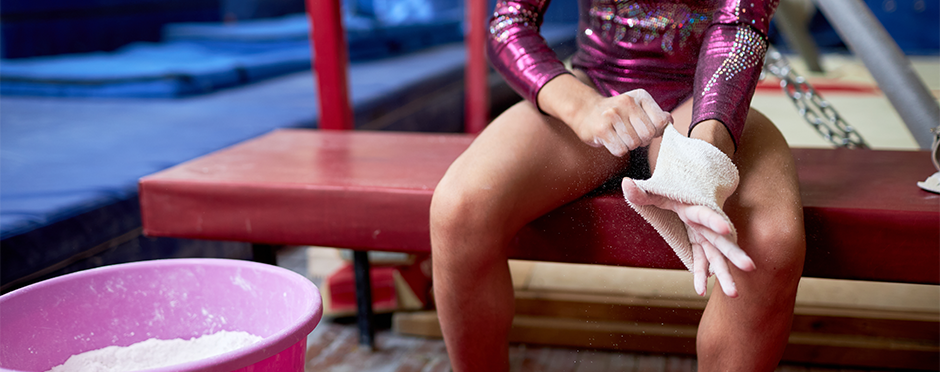
Avoiding Wrist Pain and Injuries in Gymnastics
Leave a CommentGymnastics, the sport most watched in the Summer Olympics, engages viewers because of the extreme strength, balance, agility, accuracy, and endurance required to compete. Years of training tax the gymnast’s body to the utmost because movement refinement through repetition exposes the gymnast to many repetitive stress and traumatic injuries. While gymnasts range from the 5-year-old tumbler to the elite Olympian, a unique factor for this sport, no matter the level, is the requirement of using arms for weight bearing. Such compressive and twisting forces affect the entire arm, especially the wrist. Approximately 88% of gymnasts reportedly experience wrist pain according to one study.
It is estimated that the wrist can take up to 16 times one’s body weight during floor routines, pommel horse, vault, and balance beam. Here’s a closer look at common conditions many gymnasts face and ways to mitigate injuries.
1. Repetitive Stress Injuries
Gymnast wrist (Distal Radial Physeal Stress Syndrome) is most common in female gymnasts ages 12-14 who practice greater than 35 hours per week. Such prolonged loading during the gymnast’s growth spurt can affect the growth plate in the radius bone, causing a stress fracture and, if ignored, premature closure of the bone.
Other wrist bones and ligaments can also be stressed or sprained enough to cause joint instability or compression between wrist bones, as the ligaments can no longer keep the bones aligned correctly.
To mitigate chronic stress on the wrist, ensure that mats are not too soft leading to wrist hyper-extension during tumbling. Improve wrist weight bearing by avoiding elbow hyper-extension. Also, practice precise weight bearing on the hand in pushups or planks by rotating palm weight onto the index finger away from the small finger. This practice of rotating weight can then be worked into progressive positions and incorporated into tumbling. Remember to use alternate landing surfaces during practice (mats, pit, rod floor, spring floor).
Including wrist, finger, elbow, and shoulder stretches in a gymnast’s warm-up is important. Flexible shoulders add a range of motion during tumbling tasks and, thus, decrease wrist requirements.
Maintain a consistent strengthening program for the entire arm, including shoulder blade muscles and core, as well as for the wrist and grip. Using a wrist roller attached to a light weight in a great way to build grip strength. Trying planks on fingertips can be utilized to progress to finger pushups, but this progression requires that wrist/shoulder girdle/elbow strengthening has already been in progress.
If wrist discomfort develops, do not use wrist guards without a medical consultation. Most repetitive stress injuries occur when the gymnast ignores discomfort and assumes pain is inevitable. The sooner the issue is diagnosed, the sooner the gymnast can return to practices and competitions.
2. Traumatic Wrist Injuries
Falls on the outstretched hand or direct hits could fracture any wrist bone or a combination of wrist bones. For example, landing on the wrist in hyper-extension with the hand turned toward the thumb increases the risk of a scaphoid fracture (a small carpal bone on the thumb side of the wrist).
For male gymnasts, a grip lock injury on the high bar can result in tendon injuries as well as wrist bone fractures. Grip lock occurs when the fingertip leather of the dowel grip becomes caught on the bar near the palm and locks while the gymnast rotates on the high bar. Two risks for this injury are positioning in a pronated over-grip on the high bar and not changing the dowel grip frequently enough to avoid grip wear and stretch. Using safe and unworn equipment is a must. Make sure wrist guards and grips are not overused and fit properly.
Listen to Your Body
Proper equipment and gear, rest, warm-up and cool-down, technique, routine variation, and conditioning are necessary to help prevent repetitive and traumatic injury to the wrist. Yet, once wrist discomfort develops, don’t delay getting it diagnosed before more damage occurs that takes the gymnast out of their sport for longer periods. Depending on the problem, rest, wrist guards, anti-inflammatory medications, and, if severe enough, immobilization or surgery may be required. An Athletico hand therapist can help the gymnasts return to their practices and competitions by designing a tailored program for their injury and skill level. Get started by scheduling a free assessment today to learn more.
*Per federal guidelines, beneficiaries of plans such as Medicare, Medicaid, Tricare, VHA and other federally funded plans are not eligible for free assessments.
The Athletico blog is an educational resource written by Athletico employees. Athletico bloggers are licensed professionals who abide by the code of ethics outlined by their respective professional associations. The content published in blog posts represents the opinion of the individual author based on their expertise and experience. The content provided in this blog is for informational purposes only, does not constitute medical advice and should not be relied on for making personal health decisions.
References:
1. Webb, Brian G.; Rettig, Lance A.. Gymnastic Wrist Injuries. Current Sports Medicine Reports 7(5):p 289-295, September 2008. | DOI: 10.1249/JSR.0b013e3181870471
2. Farì G, Fischetti F, Zonno A, Marra F, Maglie A, Bianchi FP, Messina G, Ranieri M, Megna M. Musculoskeletal Pain in Gymnasts: A Retrospective Analysis on a Cohort of Professional Athletes. Int J Environ Res Public Health. 2021 May 20;18(10):5460. doi: 10.3390/ijerph18105460. PMID: 34065250; PMCID: PMC8160814.
3. Experimenting to Eliminate Wrist Pain in Handstands and Tumbling – Gymnastics Zone
4. Bezek EM, Vanheest AE, Hutchinson DT. Grip lock injury in male gymnasts. Sports Health. 2009 Nov;1(6):518-21. doi: 10.1177/1941738109347965. PMID: 23015916; PMCID: PMC3445154.
5. Wrist Injuries – Gymnastics Medicine
6. Gymnastics-Medicine-Gymnast-Wrist-2022.pdf (gymnasticsmedicine.org)
